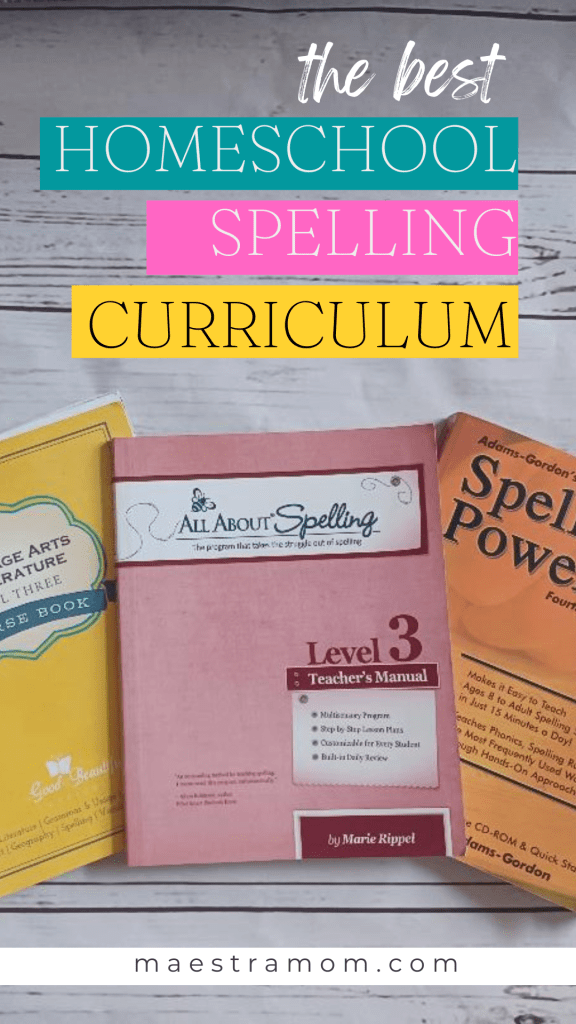Which homeschool spelling curriculum is the best? With so many different spelling programs out there, it can be hard to know which one to choose for your kids. But I’ve tried three popular homeschool spelling curriculum options with my own crew and we’ve found a clear winner!
Spelling is one of the hallmarks of a good, well-rounded education. Finding an easy-to-use, effective homeschool spelling curriculum is a must.
Disclaimer: I’ve only ever tried three homeschool spelling curriculum options because once I found my favorite, I stopped looking and don’t plan to try anything else. I love them so much, I even became an affiliate (so, yes, this post contains affiliate links).
Homeschool Spelling Curriculum Options
Let me share three homeschool spelling curriculum options we’ve tried and the pros and cons of each. Then, I’ll tell you the one that stood out head and shoulders above the rest and – eek! – a FREE homeschool spelling curriculum giveaway at the bottom of the post.
Homeschool Spelling Curriculum #1: Spelling Power
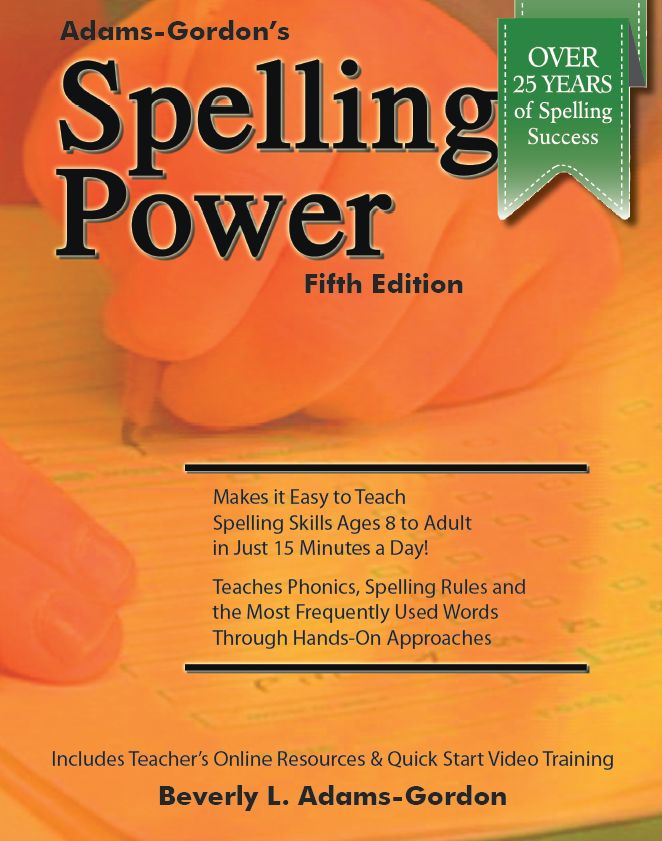
Spelling Power was our very first spelling curriculum when we began homeschooling. A seasoned home-school mom recommended it because she had used it with all her crew, and it worked great for them. We gave it a go for several years. While I didn’t like it much (spoiler alert), the program seemed to be effective, so I left it alone for my oldest daughter. To be fair, today she is an excellent speller. Spelling Power is an all-in-one book program that works for ages 8 to college. Words are organized by phonetic principles and spelling rules as well as covering the 5000 most frequently used words.
How Does Spelling Power Work in a Nutshell?
- The first week, you use their placement exams to place your child on the right level to begin instruction. It does not matter what grade level they are in or if they are ahead or behind. You also teach your child how to use the program.
- After that, the daily ritual is more or less the same until you reassess at the end of the year. Just repeat.
The Daily Ritual = 15 minutes
- 5-minute daily test
- 5 minutes studying misspelled words (with a 10-point checklist to follow for each word)
- 5 minutes skill building activities
Spelling Power PROS:
- Cost. You only need to buy 1 book to teach kids ages 8 through college level. Not going to lie – this was a big selling point for me initially because I was on a budget and had multiple levels of kids.
- Teaches phonics, spelling rules, and sight words. Words are grouped into patterns and kids learn a group rule that explains the pattern logically.
- Mastery-based. Kids only learn words they don’t know. They never waste time studying words they already know. This allows for faster progress
- 15 minutes. It is designed to take only 15 minutes a day.
- Grade-level spelling placement assessments. This is honestly why this book is still sitting on my homeschool shelf today. From time-to-time, I still like to give my kids a grade-level placement spelling exam just to make sure they are working on or above grade-level. It also helped me know when to stop teaching spelling.
- Self-paced. Because of the unique design, a child can progress very quickly through the program. Alternately, it provides review and can move as slowly as needed. Instead of being tied to a grade-level, the level is unique for each child.
Spelling Power CONS:
- Too repetitive. Words are frequently repeated and my kids got tired of seeing words over and over.
- Daily Tests. You’re supposed to do a quick 5-minute spelling exam daily – it’s really a pre-test. If the child already knows the words on the list, you skip them, and they are not studied. The point is to only require a child to do activities with words they need to master. While this sounds exciting, for my kids it had the opposite effect. It made them feel bad – like they were missing everything. And since it is a daily aspect of the program, it was like a daily 5 minutes of “look what you don’t know.” They really hated it.
- Not multi-sensory. While it claims to be multi-sensory, the burden is on the parent to make it that way.
- Very reliant on reading and writing. The is program might a good fit for you if your child is a traditional paper and pencil learner. That’s why it was effective for my first daughter. For my son who was dyslexic, is was a terrible fit.
- Time. The whole process is supposed to take about 15 minutes a day. However, most days it ended up taking us longer.
- Too much prep. The manual came with 134 different skill building activities and optional (add-on cost) Activity Task Cards. We never purchased those and maybe this would have worked better if we had bought them. Without them, I felt like the burden was on me every day.
- Boring. Ultimately, we just did not find this spelling curriculum to be engaging.
Homeschool Spelling Curriculum #2: The Good & The Beautiful Spelling
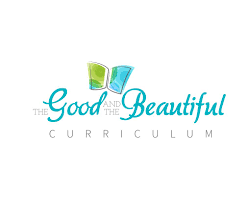
The Good and The Beautiful spelling is embedded naturally into the Good and the Beautiful Language Arts Coursework and is not a separate stand-alone program. Their philosophy is that spelling should not be taught as random lists of words but should be absorbed through a natural process of reading, practicing phonics principles, learning spelling rules, and frequent practice of carefully selected words. This method appealed to me because I already loved the Good and the Beautiful and the idea of teaching spelling naturally. But, I soon hit some frustrations.
How Does the Good and the Beautiful Spelling Work In a Nutshell?
- Students are exposed to the spelling rules and words in their Language Arts lesson.
- There is no need to set aside a separate “spelling” time as it is embedded in the lesson.
- Spelling is fixed by grade-level. Student are exposed to the spelling and phonics rules, and the spelling words, attached to that grade level Language Arts book.
- In the lessons, parent and child read together and then students have independent work that includes spelling practice.
The Good & the Beautiful PROS
- Open & Go. No prep work required! Everything is provided in the scripted lessons.
- Easy to use. The spelling is very easy to follow and use as it is embedded in the lesson.
- Time-Saver. Since spelling iss embedded in the lesson, there is no need to set aside an additional 15 minute time slot for it daily.
- Consistent, Fun Practice. As part of the independent work, students are prompted to practice spelling words in fun, engaging, multi-sensory, or silly ways. This included things like writing spelling words on silly doodles, on the window, or while doing prescribed exercises.
- No additional cost. Enough said.
The Good & the Beautiful CONS
- Tough Words. The words often seem too difficult for my kids. While the text introduces one phonics concept or spelling rule, the spelling words do not necessarily match what is taught. So, I felt like I was teaching one thing while my kids were doing something else for practice. Also, they introduce commonly misspelled words that seemed over-all really hard!
- Not logical. The spelling words are not grouped necessarily by word families or patterns. While there is some of this (and it is covered elsewhere in the lessons), the spelling words themselves did not always reflect what was taught in other ways. The spelling lists seemed disconnected from the lesson, as if a different person wrote that pat as compared to the rest of the book.
- Paper & Pencil Practice. While there are some prompts to do fun, multi-sensory activities, most days the spelling practice is simply using pencil and paper. Which works well for some kids, but not others.
- One-size fits all. The spelling words in the lessons often seemed too hard for my child, while the other aspects of the lesson (grammar, reading, writing) were on-target. Somehow the spelling words didn’t seem to mesh with the rest of the lesson, so I kept feeling the frustrating need to modify that part while keeping up with the rest of the material. Ultimately, we ended up continuing to use The Good and The Beautiful coursework but substituting the spelling portion entirely.
NOTE: In their newly updated version, it looks like the Good and The Beautiful has added an additional Spelling Practice Book to some levels. I do not know how this changes the program.
Homeschool Spelling Curriculum #3: All About Spelling
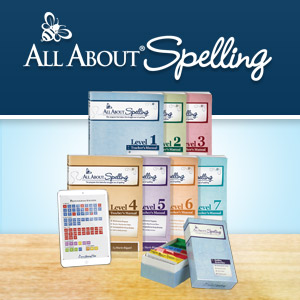
All About Spelling is a complete spelling curriculum offering levels 1 through 7. It claims to be “the program that takes the struggle out of spelling”. It is a step-by-step, multi-sensory program based on the Orton-Gillingham approach. It focuses on teaching spelling by grouping words into word families and patterns while introducing sight words and commonly misspelled words, too. And it does all of this through a non-traditional auditory (hearing), visual (seeing), and kinesthetic (touching) mode that is highly engaging for kids. This is the program with the amazing hands-on, colorful magnetic tiles that kids adore!
How does All About Spelling Work in a Nutshell?
1. Placement Test. The first thing to do is to have your child take the free online placement test. While the seven levels roughly correspond with traditional grade levels, your child should begin where they need to learn!
2. The Daily Ritual = 5-15 minutes
- Mom and child sit down together. Grab the teacher’s manual then open and read with no prep needed!
- Use the interactive magnetic tiles to teach the lesson
- Go over the Word Cards
- Do sentence dictation
PROS
- Open & Go. Absolutely no prep needed! The lessons are scripted and after you get the hang of the program, you won’t even need to read it word for word. Just a quick glance is enough to let you know what you need to teach.
- Easy to use. SO easy to use! This is truly the most user-friendly spelling program out there!
- Fast. Our lessons usually take anywhere from 5-15 minutes. As mom, I only need to be involved one day of the week. The other days of the week my kids work independently.
- Multi-sensory. This is the biggest reason we switched to All About Spelling. Instead of endlessly writing lists of words, kids use color-coded letter tile magnets on a magnetic board. These are not just typical magnetic letters you can buy at the dollar store. The consonants and consonant teams (like br) are blue, the vowels and vowel teams (like ea) are red, but there are also tiles of many other colors grouped by their function. For example, suffixes are pink, the sounds of /er/ are purple, etc. You get the idea? There are also tile sets for prefixes, consonant teams, and other blend combinations, too.
- Engaging. As kids use these letter tiles, they are actually having fun! My kids love building their words with the tiles. They are using their whole body and senses, so the learning really sticks! There are also word cards for review, too.
- Customizable. Most of the levels contain 28 lessons. In our home, we typically do one lesson each week. Since a homeschool year is usually 34-36 weeks long, it is easy to complete at least one level each year. However, a parent could definitely speed things up and complete 1 ½ to 2 levels in a year if your child is behind.
- Independent. After spending one day each week on a Mom-led spelling lesson, my kids work independently the rest of the week. They practice their spelling using the interactive tiles , the word cards, the spelling app, or any other way they want to practice and master their spelling words.
- Struggling Learners. If your child is a non-traditional learner, this is the spelling curriculum for you. This approach to spelling is highly effective for kids with dyslexia, dysgraphia, auditory processing disorder, and other struggling learners. Look no further.
- Spelling App. If you want to shake up the fun, there’s a Letter Tiles App available, too, where kids can even hear the phonograms pronounced!

CONS
- Cost. I love this program so much, but the cost is definitely a turn-off. In all honestly, I would have tried this program years earlier if it had been cheaper. But now, having used it after being frustrated with other programs, I can honestly say All About Spelling is worth Every. Single. Penny. And if you are homeschooling multiple kids, you will get to reuse it over and over.
Plus guess what? They are running a giveaway for a free All About Spelling level of your choice. How cool is that? Click the pic below to sign up!
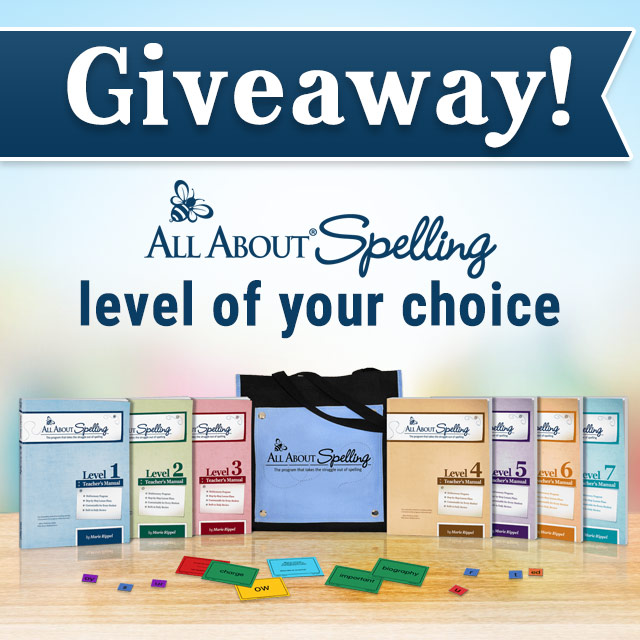
Which homeschool spelling curriculum is the best?
So, after 9 years of homeschooling and trying three different homeschool spelling curriculum options, the clear winner is All About Spelling
I originally was drawn to this program because my dyslexic son was really struggling in spelling. But after using it with him, I discovered that the program is fun and effective for all kids – whether they are a struggling learner or not. Now, I use the program with my other kids, too, and across the board it is THE favorite homeschool spelling curriculum for everyone.
That’s a win!
Looking for a homeschool MATH recommendation? Try Nicole the Math Lady.
